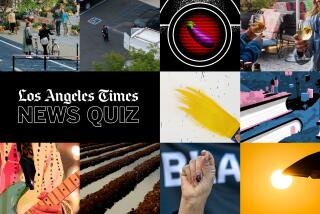No Airhead on Aviation Facts, Even Wrong Ones
- Share via
As one of the nation’s premier repositories of aviation history and artifacts, the Aerospace Museum in Balboa Park gets calls every day from scholars, journalists and flight buffs.
The queries can be general--”Tell me something about the development of jets”--or quite specific--”What were the names of the crew members in the fourth plane that took off in Jimmy Doolittle’s raid?” Archivist Ray Wagner handles them all with aplomb, using the museum’s 50 file cabinets of documents, histories and photographs.
Even by those standards, a dozen or so letters and long-distance calls asking the same question recently were unique. Many were in French. And all were asking about something that never happened.
It turns out that the Paris newspaper Le Figaro was running a contest with multiple-choice questions, including one asking which of three aviators was the pilot on a historic 1936 flight from San Diego to Moscow. Unbeknown to Le Figaro, the second-largest paper in France, there was no such flight.
There was, however, a historic 1936 flight from Santa Monica to Moscow, and the pilot, Sigsmund Levaneski (a.k.a. “the Soviet Lindbergh”), was among the three choices provided by Le Figaro. He flew a 27 Downey Vultee, from the Downey-based Vultee aircraft works, which later merged with San Diego’s Consolidated, giving rise to Convair.
Providing the information about Levaneski (including the fact that he disappeared over the North Pole on a return flight) was no problem for Wagner, 64, a retired history teacher and author of several books on aviation. Asking about a 27 Downey Vultee is like asking him what he had for breakfast.
“The hardest part was struggling with my college French,” Wagner said. “The first caller spoke no English and apparently thought that, if there was anyone of any intelligence here, they would, of course , speak French. Somehow we managed.”
Is That Clear?
The Public Utilities Commission will meet today in San Diego to discuss rules for the upcoming hearing on the proposed merger of SDG&E; and Southern California Edison. But don’t figure on the controversy being less complex once the hearing is held.
The PUC this week issued a new guide to the hearing process--not the issues, just the process. It’s 103 pages.
America’s Pub Race
Move over America’s Cup Race. Make room for America’s Pub Race, the latest entry in seafaring competition. It began when U. S. and New Zealand journalists began arguing at Bula’s Pub & Eatery in Coronado over which country produces the best sailors.
Suddenly a challenge was set. Sail in one-man, 14-foot Lasers from Coronado to the Embarcadero in San Diego, hoist a few at Anthony’s restaurant, sail to the Charthouse restaurant near the San Diego-Coronado Bay Bridge, hoist a few more, then sail into Glorietta Bay, land in Coronado and play your respective national anthem on the musical instrument of your choice.
For the latter part of the contest, the two Kiwis, brothers Bill and Hugo Manson, chose bagpipes and a kazoo. The Americans, Joseph Ditler and Larry Edwards, chose a fiddle and a Jew’s harp.
America’s Cup loser Michael Fay learned of the grudge match and sent his New Zealand countrymen a telegram wishing them “favorable winds and a strong drinking arm.”
They proved to have both, placing first and third and winning on cumulative time. A 3-inch trophy in their honor now rests above the bar at Bula’s.
“I figure the whole thing cost $42.50, which is $59,999,957.50 less than the America’s Cup,” Bill Manson said. “We only had one rule: Nobody resorts to lawyers to overturn the decision.”
More to Read
Sign up for Essential California
The most important California stories and recommendations in your inbox every morning.
You may occasionally receive promotional content from the Los Angeles Times.













